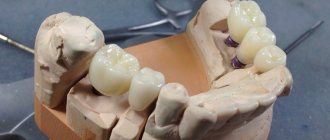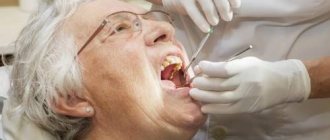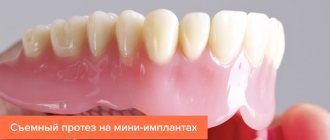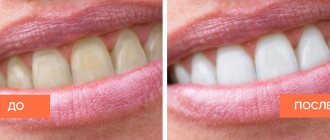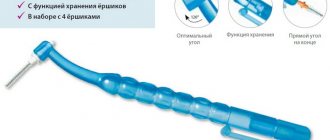Description of the main characteristics of alloys
Hardness as the property of a material to resist the penetration of an indenter—another solid body—into it. This parameter determines the occlusal wear resistance and how the dentist can process and polish the prosthesis.
The yield stress is the stress required to cause permanent plastic deformation in tension. The proof strength is the stress that occurs at a strain of 0.2%. This parameter characterizes the strength of the alloy more than others. This is what people pay attention to first when choosing the design of a prosthesis.
The elastic modulus is another important property that determines the flexibility of a metal frame. An alloy with a high modulus of elasticity bends less under load than an analogue with a low modulus.
Elongation is the ductility of a material, measured as a percentage. The lower this indicator, the more fragile the alloy will be.
The melting temperature range is an important parameter to prevent frame deformation when firing ceramics.
Biocompatibility means that the alloy material is safe for the tissues of the body and humans in general. Non-noble alloys have mixed biocompatibility and should be used with caution.
Manufacturability is the maximum precision in manufacturing and processing of the frame.
The coefficient of thermal linear expansion indicates the compatibility of the alloy with ceramics. The main condition is that the coefficients of the alloy and ceramics must match as much as possible, and there should be no residual stress left in the finished restoration.
Properties of noble alloys
The ideal option, according to most dentists, is expensive gold-platinum alloys. They have impeccable mechanical and physical properties, high biocompatibility and are well combined with ceramics. The most famous noble alloys produced in Russia are “Plagodent” and “Plagodent Plus”.
Palladium in combination with gold forms alloys with excellent physical and mechanical properties and high corrosion resistance. They have a decent yield strength and high tensile strength, so long bridges and permanent elements of locking joints are made from them. In appearance they resemble base alloys. Only 10% palladium in the composition gives the alloy a white color, similar to steel.
Working with palladium structures requires certain skills from the dentist due to the high melting point of the alloy and special casting techniques. Soldering and laser welding should be avoided. Gold-palladium alloys are cheaper than gold-platinum alloys: due to different densities, the difference in cost can reach 2-2.5 times.
The percentage of noble metal in the alloy affects corrosion resistance and biocompatibility. The cost of a prosthesis can only be reduced by switching to non-precious alloys. A noble alloy may contain a high or low gold content, or may not contain this element at all, as, for example, in silver-palladium compositions.
Precious metal alloys and molded titanium bases Parunov V.A., Lebedenko I.Yu., Stepanova G.S., Vasekin V.V. MGMSU, FSUE NPK "Supermetal", Moscow1. Alloys based on noble metals Recent trends in the development of dental materials science are closely related to both the development of science and the urgent needs of dentistry. The deterioration of the global environmental situation, demographic changes with an increase in the proportion of older age groups of the population, changes in the nature of nutrition, and increased aesthetic requirements determine the important role and rapid development of research in orthopedic dentistry, and necessitate the emergence of a variety of new materials used in dental practice. The use of traditional base alloys based on cobalt, nickel and chromium for prosthetic dentistry is likely to be gradually reduced due to the possibility of adverse reactions in some patients sensitive to the effects of base metals. Therefore, the second half of the last century is characterized by a rapid growth in the number of materials based on precious metals in dentistry. The world's leading companies have developed and offered to the dental materials market a wide range of alloys based on gold, platinum and palladium, which satisfy almost the entire range of requirements of modern prosthetic dentistry. And the pace of research and development of new alloys based on precious metals is not slowing down by the end of the century, but in some areas is increasing sharply. Alloys for the frames of metal-ceramic and metal-composite prostheses are especially widely developed and introduced into dental practice. In the mid-80s, with the appearance on the Russian market of imported high-performance dental alloys of noble metals of various compositions and purposes, Russian dentists could not oppose them with any competitive domestic materials, the range of which at that time was extremely limited, and their consumer properties did not meet modern ones standards. In general, the level of domestic dental structures made of precious metal alloys until the 90s can be assessed as follows: – domestic gold alloy of 900 grade due to poor wear resistance could not be used for the manufacture of heavily loaded dentures; – 750 grade alloy is not widely used; – silver-palladium alloys for stamped parts of dentures did not provide the necessary biocompatibility with oral tissues; – the formulation of cadmium-containing gold solder predetermined the harmful effects of cadmium on the human body. Considering this serious lag in domestic dental materials science in the field of alloys, in the mid-90s, measures were taken to create new dental materials and structures based on noble metals and titanium, not inferior to the best world standards. FSUE NPK Supermetal, together with the Moscow State University of Medicine and Dentistry, was the first in Russia to propose new high-performance alloys based on gold, platinum and palladium that can be widely used in orthopedic dentistry. The ideology of creating new alloys based on noble metals is based on the principles of the maximum possible combination of high technological characteristics of alloys with their excellent functional properties. The created alloys have a high content of noble metals (the sum of gold and platinum group metals is 70–98%) and do not contain alloying elements (Cd, Ni, Be). capable of causing harmful allergic or toxic effects on the human body and are highly corrosive and biologically inert. The alloys meet the highest requirements of the world practice of dental prosthetics and, in terms of their medical and technical data, comply with ISO standards.
The former name of this alloy (Super-TZ) includes the concept of “heat-strengthened gold.” This is a thermally hardenable wear-resistant alloy that is used for stamped and cast dental structures (crowns, bridges with and without polymer coatings). The alloy contains 75% gold, has a beautiful yellow color and corresponds to group III alloys according to the international standard ISO 1562-84. The melting range of the alloy is 880–950 °C, hardness in the cast state is 1,375, after heat treatment – 2,000–2,200 N/mm2, density 15.5 g/cm3, yield strength 250 N/mm2, relative elongation 20–25%. Analysis of clinical trials and ten years of practice in the use of GOLHADENT alloy confirms its high technological and functional qualities. FSUE NPK "Supermetal" mass-produces the GOLHADENT alloy in the form of granules, disks and wire. GOLHADENT has also found its application in the manufacture of acupuncture needles and “STYLDENT” dental jewelry, which is fashionable among young people. If there are alloys, then there must be solders. Gold-containing cadmium-free solder 750 standard – BECADENT (formerly “Superbecam”) is also our new development. Everyone knows from materials science textbooks that most traditional gold dental solders contain cadmium, which lowers the melting point of the solder, preventing melting of the parts being joined. The results of numerous studies confirm that cadmium is a serious environmental pollutant and has adverse effects on the human body. One of the main features of cadmium metabolism is its rare ability to accumulate in the body (half-life 40 years). This leads to the need to exclude cadmium from the composition of dental alloys. In the European Union countries, cadmium-containing solders have been banned for a long time. The main characteristics of our solder are no worse than those of traditional cadmium-containing gold solders: golden yellow color, melting point below 800 ° C, adhesive joint strength, corrosion resistance, fluidity, wettability are at the level of the properties of gold solder AuAgCdCu 750–30. Available in the form of wire and plates.
| Rice. 4. Clasp dentures with KEMADENT coating |
We present the KEMADENT material (formerly Super-KEMZ) for wear-resistant gold coating (Fig. 4). Despite the active expansion of materials based on noble metals in dental practice, modern prosthetic dentistry still widely uses non-precious metal materials due to their lower prices. Dentures or their parts made of non-precious alloys in many cases require additional processing in order to increase their corrosion resistance or improve aesthetic qualities. Most often, thin metal coatings based on noble metals are applied to such structures by galvanic means. The main requirement for these coated structures is high wear resistance. Thus, the creation of the KEMADENT gold coating was timely and theoretically justified. KEMADENT coating is intended for electrochemical coating of dentures made of base metals. The maximum hardening effect is achieved by increasing the concentration of non-metallic particles. The coating is based on gold (98.5%) containing up to 0.5% zirconium oxide ZrO2. In addition to the materials listed above, intensive work is currently underway on new alloys. A gold-based alloy for clasp dentures and a high-temperature alloy - solder for noble alloys for metal ceramics - are ready and undergoing clinical trials. 2. Titanium bases obtained by superplastic molding All practicing dentists are familiar with removable plate dentures and the acrylic plastic from which they are made. For almost 70 years, acrylic plastics have been the main base materials for the manufacture of removable dentures, and all the disadvantages of acrylic plastic have been well studied. This is the fragility of plastic dentures and frequent breakdowns, which have become commonplace in dental clinics. These are the so-called phenomena of “intolerance”, which include denture stomatitis caused by: – poor processing of dentures; – disruption of the polymerization process; – increased colonization by microorganisms as a result of poor hygiene. The low thermal conductivity of acrylic plastics leads to disturbances in thermoregulation of the oral cavity. All of the above problems gave rise to the emergence of removable dentures with metal bases. Everyone knows metal bases made of cobalt-chrome alloy. However, they are quite notorious for their severity and difficulty in adapting to them. Titanium bases can be an effective alternative. In general, titanium is a metal of great future in dentistry, because it is biologically safe, has resistance to corrosion, has excellent mechanical properties and excellent biocompatibility, so it is not surprising that new technologies go hand in hand with this metal. Dentures made from titanium alloys can be made in several ways. One of them is milling. Thus, CAD/CAM systems for computer-aided milling have been developed abroad and are currently being widely implemented. Along with milling technology, plasma spraying and powder metallurgy are being further developed. In dentistry, titanium powder metallurgy is used mainly for the manufacture of removable laminar dentures. A mixture of titanium powder of various dispersion, distilled water and a binder component is packaged like acrylic plastic. Then it’s all sintered in a vacuum at 1,000 °C for an hour. Plasma spraying is the application of coatings from powder or wire blanks to a substrate, while the sprayed material is fed into a high-temperature plasma jet, melts in it, accelerates and, hitting the substrate, firmly adheres to it. For this purpose, a special device is used - a plasmatron. For 15 years, titanium denture casting has been promoted in Japan, the USA and Germany, and more recently in Russia. Various types of equipment have been developed for centrifugal or vacuum casting, X-ray quality control of castings, and special refractory materials. The methods listed above are very technologically complex and expensive. A way out of this situation may be superplastic molding. What is “superplasticity”? The bottom line is that at a certain temperature, a metal with an ultra-fine grain behaves like a heated resin, that is, it can elongate by hundreds and thousands of percent under the influence of very small loads, which makes it possible to produce thin-walled parts of complex shapes from a sheet of titanium alloy. This phenomenon and the process consists in the fact that a superplastic sheet blank is pressed against a matrix and under the influence of a small gas pressure (maximum 7–8 atm) it is superplastically deformed, taking on a very precise shape of the matrix cavity in one operation. A denture made by superplastic molding has significant advantages: lightness compared to dentures made from cobalt-chrome or nickel-chrome alloys, and high corrosion resistance and strength. The sufficient simplicity of manufacturing the prosthesis makes it indispensable for mass production in orthopedic dentistry. The initial clinical stages of manufacturing a complete removable denture with a titanium base do not differ from traditional ones in the manufacture of plastic dentures. This includes a clinical examination of patients, obtaining anatomical casts, making an individual tray, obtaining a functional cast, and making a working high-strength model from superplaster. A model made of supergypsum with an alveolar ridge pre-insulated with clasp wax is duplicated into a fire-resistant mass. Fireproof models are placed in a metal holder made of a heat-resistant alloy, which has special cutouts, the size and shape of which allows the model of the upper jaw of any patient to be placed in it.
| Rice. 5. Diagram of the apparatus for superplastic molding |
A titanium alloy sheet 1 mm thick is placed on top of ceramic models. The sheet blank is clamped between the two halves of the mold. The mold halves form a sealed chamber, divided by a sheet into two parts, each of which has a communication channel with the gas system and can be independently either evacuated or filled with an inert gas under some pressure (Fig. 5). The sealed mold halves are heated and create a pressure difference . A vacuum of 0.7–7.0 Pa is created under the sheet. A sheet of titanium alloy bends towards the evacuated half-mold and is “blown” into the ceramic model located in it, fitting its relief. During this period, the pressure is maintained according to a certain program. At the end of this program, the mold halves are cooled. After this, the pressure in both halves is equalized to normal and the workpiece is removed from the mold. Bases of the required profile are cut along the contour, for example, with a laser beam, the edge is ground on an abrasive wheel, scale is removed, retention strips are cut with an abrasive disk in the saddle-shaped part of the base to the middle of the alveolar process and electropolished according to the developed method. The plastic stopper is formed at different levels of the titanium base from the palatal and oral surfaces below the top of the alveolar ridge by 3–4 mm, using the chemical milling method. Chemical milling is also carried out along line “A” to create a retention area when fixing the base plastic. The presence of plastic along line “A” is necessary for further correction of the valve zone.
| Rice. 6. Ready-made removable dentures with titanium bases |
In the clinic, the doctor determines the central relationship of the jaws using traditional methods.
The setting of teeth and fitting in the oral cavity do not differ from usual ones. Next, the laboratory replaces the wax with plastic and polishes it. At this point, the production of a removable denture with a titanium base is completed (Fig. 6). For superplastic molding, domestic technology, domestic installation (original Russian patented installation and methodology) and domestic sheet blanks of domestic alloy VT 14 are used. It can be confidently stated that superplastic molding of titanium alloys has excellent prospects for further development in our country. And we recommend this method to practicing doctors. Recently created new structural materials open up new wide possibilities in the field of dental prosthetics, thanks to their unique properties that combine high durability, bioinertness and aesthetics. You can find out more about these and new materials by calling 963-40-37 and 963-60-09 or go to the website stildent.ru
(No. 3 (44) 2004) p. 14
What determines the color of noble alloys?
Doctors pay attention to color. It is believed that a very yellow alloy containing a lot of gold improves the color of ceramics: the oxides of such alloys are easily coated with a thin layer of opaque and look aesthetically pleasing. A patient who observes the golden color of the crown frame at intermediate stages has no doubt about the need to purchase such an expensive prosthesis.
In some noble alloys, the proportion of palladium, platinum or silver is increased, so they lose their yellow color, but remain just as strong. Such varieties are suitable for the manufacture of extended bridges, with or without implant support. If you are going to install a single crown, you can get by with an option with a high gold content and a low content of platinum group metals.
Alloys with fewer noble components have a pronounced yellow color and do not have such good properties as white alloys. They contain a high content of indium, which in combination with palladium gives a bright straw color. They do not have sufficient elasticity and corrosion resistance. They are used mainly in China and India on a massive scale to reduce the cost of dentures.
Stages of manufacturing a metal-ceramic bridge prosthesis
The main indication for prosthetics using fixed bridges is the absence of one or more teeth.
Dental prosthetics using fixed metal-ceramic prostheses is one of the most common methods of treating violations of the integrity of the dentition and restoring chewing function. For this purpose, missing teeth are replaced with artificial ones, supported by adjacent teeth. The functional basis of such treatment is the reserve capacity of the dentition, which allows it to withstand additional load.
A fixed metal-ceramic bridge prosthesis is a structure consisting of one or more artificial (metal-ceramic) teeth rigidly attached to adjacent natural teeth using fixing elements - metal-ceramic crowns.
Typically, the number of supports in a bridge is two, but sometimes there is a need for three or more supports. Due to the fact that the supporting teeth experience pressure not only directly on them, but also on the intermediate part of the bridge, the number of replaced teeth cannot be too large. As a rule, this is 1-2 teeth.
The manufacturing process of a metal-ceramic bridge consists of clinical and laboratory stages.
Clinical stage
After the examination, if necessary, preliminary treatment is carried out: gum treatment, filling of supporting teeth and, if this is unavoidable, removal of the pulp and filling of root canals.
Then the teeth are prepared, on which the crowns that are part of the metal-ceramic bridge will be placed. This stage consists of grinding down their convex surfaces that prevent the crown from being put on.
After processing the teeth, an impression is taken and a plaster model of the missing dentition, along with data on the state of the bite, is sent to the dental laboratory.
Laboratory stage
In the laboratory, jaw models are made, on which the frame of the bridge is formed from wax, and then the metal frame is cast in a foundry.
Then the frame can be coated with a golden sublayer, which, due to the high gold content, allows the ceramic mass to be applied in an ultra-thin layer, through which the black or dark gray color of the oxide film covering the surface of the metal frame will not show through.
Next, the frame is covered with ceramic mass. The ceramic coating is applied in layers in accordance with the colors selected by the orthopedic surgeon. The “face bow” data is transferred to the articulator and the bridge is finally modeled in shape, taking into account the bite and relationship of the teeth during movement.
A bridge is a rather complex structure, so another intermediate visit is required - fitting of the frame. During the third visit, the final correction is made. The ceramics are covered with glaze, which gives the prosthesis a natural look, and with the help of special cement, the metal-ceramic prosthesis is fixed to the teeth.
Stages of manufacturing a metal-ceramic crown
The traditional manufacturing process of metal-ceramic crowns involves the following steps:
- Determination of tooth color, characteristic features, structure of enamel, dentin, determination of the transparent layer, the presence of individual characteristics (enamel cracks, staining of fissures in the chewing group of teeth, the presence of chalky stains, enamel abrasion, etc.).
- Next comes the removal of the destroyed dental tissue and the process of preparation (grinding) of the tooth, which takes a very long time. In order to ensure that after installing a metal-ceramic crown there is no effect of the so-called “blue” gum or compression of the gingival dental papilla by the crown, the doctor must very carefully grind the tooth to create a gingival ledge (the angle on which the crown will rest). Only with this method will the work be successful.
- An impression is then taken and sent to the laboratory.
During the production of permanent metal-ceramic structures, a temporary crown is placed, which hides the defect and eliminates psychological discomfort.
- After the metal frame is made, ceramic masses are applied to it layer by layer, recreating natural teeth as accurately as possible. Next comes the artistic design of the metal-ceramic crown, taking into account the individual characteristics of the tooth.
- Then follows the fitting of an almost finished metal-ceramic crown (a metal frame with ceramics already applied, but not glazed). At this stage, the color of the crown is finally determined, because You can still make changes.
Finally, at the last visit, the permanent crown is placed. The entire process of manufacturing a metal-ceramic crown takes on average up to 10 working days.
Materials used in metal ceramics
In metal-ceramics, a metal frame is used as a base, which solved the problems of excessive fragility of ceramics. Ceramic is applied layer by layer to the outer surface of the metal and held firmly in place by sintering. As a result, a metal-ceramic crown is reliable, durable and very beautiful. Plus, it looks like a real healthy tooth.
To effectively protect teeth from destruction under crowns, teeth are treated with a protective paste that releases fluoride into the tooth tissue. Modern dental cements are used to fix metal-ceramics, which makes it possible to achieve the strongest fixation. A high-quality metal-ceramic structure lasts for decades. The average service life of cermets on base alloys is 10-12 years. On gold-platinum alloy 15 years or more.
Ceramic lining in metal ceramics
The quality of a metal-ceramic prosthesis depends on many factors. Color accuracy is determined mainly by the quality of the ceramic mass. Imported ceramics convey color more accurately than domestic ones; in addition, they are more stable during processing and use - they do not change color when fired, and do not crack.
Applying porcelain mass to a metal frame is a long and painstaking job, since it is applied in layers and after each application the mass is fired in a special vacuum oven. Firing metal ceramics is a very important task. If the temperature or barometric modes are chosen incorrectly, the ceramics will crack and all the work will have to be done again. It is thanks to the layered application of porcelain that metal-ceramic teeth accurately convey the color and transparency of natural teeth. In addition, porcelain is intertwined with the tissues of the oral cavity and is hygienic.
Recently, ceramics have appeared in world dental practice, having a rigidity coefficient comparable to that of healthy teeth, which makes it possible not to injure or abrade antagonist teeth when chewing.
The use of the latest technologies allows you to give metal ceramics any color. Typically, the color of metal-ceramics is as close as possible to the color of the patient’s teeth. To do this, doctors use a set of small porcelain plates in the shape of a tooth (each plate has its own shade); Dentists call such sets a “color chart.” Depending on the specific situation, a metal-ceramic crown can be made so that porcelain covers only certain sides of it that are visible when smiling and talking, and the remaining parts of the crown are made completely metal.
The world leaders in the production of dental ceramics and porcelain are Ducera, Noritake.
One of the leading factors when choosing porcelain for ceramic cladding is the constancy of its coefficient of thermal expansion, which prevents the occurrence of cracks in the ceramic coating even during the manufacture of extended multi-unit structures. Some manufacturing companies produce porcelain, the coefficient of thermal expansion of which does not change during multiple firings, and is also little sensitive to the selected firing mode, therefore metal-ceramic products coated with such porcelain can be successfully fired in any dental furnace, starting from the simplest ones with a strictly specified heating rate , and ending with ultra-modern ones.
Another important criterion for choosing porcelain for metal-ceramic dentures is its strength. According to the international standard ISO 9693 “Dental metal-ceramics for dental prosthetics,” the flexural strength of porcelain must be at least 50 MPa.
Another pleasant distinguishing feature of some types of porcelain is their resistance to greening when applied to metal frames made of semi-precious silver-based alloys.
Three types of base alloys
Chromium alloys have been used in dentistry for more than eighty years. They are characterized by good corrosion resistance, strength, high modulus of elasticity, low density and affordable price.
- Nickel-chrome-containing alloys are used more often for frames for the purpose of further cladding. They contain 62-82% nickel and 11-22% chromium, as well as additives - molybdenum, silicon, manganese, iron, gallium, titanium, zirconium.
- Cobalt-chrome alloys contain 50-65% cobalt, 25-35% chromium and 2-6% molybdenum with rare exceptions.
The melting point of these alloys is between 1140 and 1460 °C. The polished surfaces of the dentures are shiny, silvery-white. Light weight, density slightly exceeds 8 g/cm3. Such alloys are excellent for installing single-type crowns and bridges on teeth; they are stronger and harder than noble alloys, but require the use of special abrasive tools during machining. Occlusal correction, polishing and removal of dentures cause certain difficulties and require much more time.
The bond between ceramics and metal is as strong as that of noble alloys. Casting is less precise, which is not noticeable on small castings. The issue of biocompatibility is questionable. Nickel and chromium are strong allergens.
- Titanium alloys have low density, excellent mechanical properties, high biocompatibility and corrosion resistance. However, casting titanium alloys for the manufacture of fixed prostheses has become obsolete due to the high cost and technological complexity of the process. Milling is much more often used.
In order to save money, stainless steel is increasingly being used for the manufacture of fixed dentures. Stamped crowns are characterized by their low cost and minimal amount of tooth preparation. In foreign dentistry they are used for temporary prosthetics of baby teeth.
Application
Crowns, fillings, bridges, dentures, dental instruments, and more are made from all sorts of combinations of alloys and metals.
Materials for creating dental crowns that are especially popular are a combination of metal and ceramics.
A metal base made from alloys of noble metals such as gold, silver, platinum or palladium has a number of advantages compared to a base made from inexpensive materials:
- Gold-based alloys are durable, can withstand heavy chewing loads, have an antibacterial effect, and are unable to cause an allergic reaction, darkening or inflammation of the gums.
- Silver-palladium alloys are more ductile and affordable, but their quality is significantly lower than gold-containing alloys. Temporary crowns are most often made of stainless steel and aluminum.
- Titanium is widely used as a material for creating crowns, solid bridges, and prostheses. Its mechanical characteristics are not inferior to some noble alloys used for dental purposes.
A persistent oxide film is formed on the titanium coating, thanks to which it is corrosion-resistant and biologically compatible with the tissues of a living organism.In addition, it is lightweight, so patients feel comfortable while wearing removable orthodontic appliances with a titanium base.
- An alloy of silver and mercury is used as a filling material. It is quite hard and durable, but raises some concerns due to the mercury content and a possible negative effect on the filling.
Only a highly qualified dentist should place a filling made from such an alloy, since the placement technology presents certain difficulties. - Metals such as nickel, titanium, silver, chromium-nickel corrosion-resistant steels are ideal for the manufacture of implants.
Implants are subject to rejection by biological tissue, as well as deformation, heavy chewing and mechanical loads.Therefore, the materials for their manufacture must have good biological compatibility, strength and corrosion resistance.
- High-hardness tungsten steel is used to make dental cutting instruments. Cheaper steel is used for probing instruments, and dispersion-hardening stainless steel is used for microtools.


